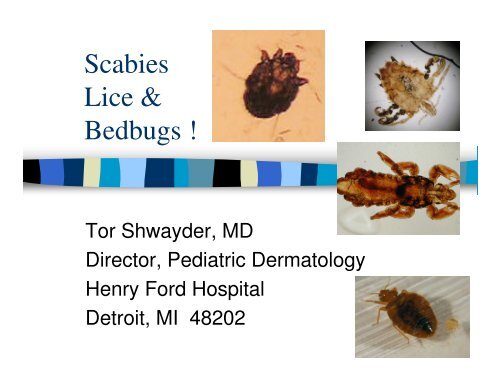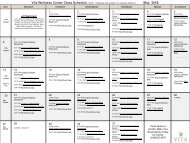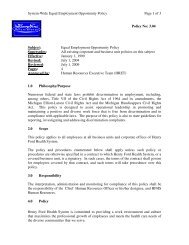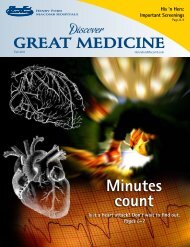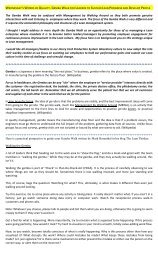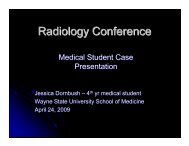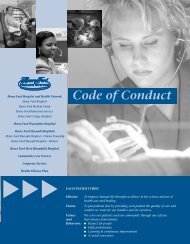Scabies Lice & Bedbugs !
Scabies Lice & Bedbugs !
Scabies Lice & Bedbugs !
Create successful ePaper yourself
Turn your PDF publications into a flip-book with our unique Google optimized e-Paper software.
<strong>Scabies</strong><br />
<strong>Lice</strong> &<br />
<strong>Bedbugs</strong> !<br />
Tor Shwayder, MD<br />
Director, Pediatric Dermatology<br />
Henry Ford Hospital<br />
Detroit, MI 48202
No conflict of interest<br />
Please turn cell phones to stun
<strong>Scabies</strong> are species specific<br />
Species specific<br />
– “var. Hominis” = Humans<br />
– Can’t blame the dog<br />
– <strong>Scabies</strong> from other animals only transient<br />
infections in humans<br />
– One of the causes of “mange” in animals
<strong>Scabies</strong>, When do you itch?<br />
10 - 30 days after infection<br />
Probably need critical mass of mites to<br />
trigger immune response<br />
Nota Bene:<br />
– Can be a month between infection and itch
10 - 30 Days Until Itch Begins<br />
“Is anyone else itching at home?”<br />
This question does not always help you!
<strong>Scabies</strong> Facts of Life<br />
Females 0.4mm x 0.3 mm<br />
Burrows 2 mm a day in upper epidermis<br />
Lays 2-3 eggs/day<br />
Lives about a month, then dies<br />
Males die after copulation<br />
How was it for you, Dear? ….. AHHHHHhhhhhhhhhhh
<strong>Scabies</strong> - Clinical Signs<br />
“Classic” signs<br />
Papules burrows in<br />
– Web spaces<br />
– Palms<br />
– Wrists
<strong>Scabies</strong> -<br />
Clinical Signs<br />
Can involve FACE<br />
– Old literature says it<br />
does not. This is<br />
simply not true<br />
Common<br />
presentation: The<br />
vague “all overs”
<strong>Scabies</strong> -<br />
Clinical Signs<br />
Classic picture<br />
Nodules in Axillae<br />
Nodules on Penis<br />
<strong>Scabies</strong> until proven<br />
otherwise!
<strong>Scabies</strong> - Clinical Pictures
More <strong>Scabies</strong> Pix
Still More <strong>Scabies</strong> Pix<br />
6 month Guatemalan Child
Clinical Distribution Percentages<br />
D Taplin & T Meinking Pediatric Derm 7:1, March 1990
Nipple <strong>Scabies</strong><br />
Women<br />
– Palms<br />
– Nipples
Male <strong>Scabies</strong><br />
Men<br />
– Penis<br />
– Glans<br />
– Scrotum<br />
Burrows on the<br />
glans a sure sign of<br />
scabies
<strong>Scabies</strong> - A Caveat<br />
Clean people - Hard to fine scabies<br />
– Physical act of scrubbing removes the mite<br />
– Total population 11-12 mites/human
The <strong>Scabies</strong> Prep - Easy to Do!<br />
Apply oil<br />
Gently scrape 15 blade<br />
Center on a glass slide<br />
Observe at low power
The <strong>Scabies</strong> Prep - Microscopic<br />
Newborn scabies!<br />
Scabetic Feces and One Egg
<strong>Scabies</strong> Microscopic Continued
<strong>Scabies</strong>, Oil Prep, Low Power
Treatment Options - Main Ones<br />
Lindane<br />
Permethrin
Lindane<br />
1% solution or cream<br />
Safe if used as directed<br />
Apply once to cool dry skin bedtime<br />
Wash off in a.m.<br />
Do not repeat
Lindane Caveats<br />
It is a toxin<br />
Almost all adverse cases reported were:<br />
– Misuse<br />
– Repeated use<br />
– Oral use!<br />
– Agricultural concentration (>1%)<br />
I do not use it on premie babies<br />
I no longer use it less than 90 lbs children<br />
– Because of AAP edicts<br />
I do not use it on erythrodermic pts<br />
It is my SECOND line drug now
Permethrins My First Line Drug<br />
Pyrethroids a flower<br />
derivative. Usually<br />
“synergized” w/ PBO<br />
Permethrins<br />
synthetic derivative<br />
– Much more effective<br />
than the natural<br />
extract
Permethrins (Elimite®)<br />
5% cream<br />
No toxicity reported<br />
Stinging sensation common<br />
Safety tested down to 2 months age<br />
– I use it from zero on up
Treatment options - Old Ones<br />
Sulfur<br />
– Been around for thousand years<br />
– No one will sue you over it<br />
– Stinks!<br />
– Have to leave it on for three days<br />
– I use it on pregnant lawyers
Sulfur - Balsam of Peru<br />
Concoction<br />
Sulfur ppt. 12 %<br />
Balsam of peru 8%<br />
Castor oil 4%<br />
Petrolatum Alb qsad 100<br />
Balsam has benzoyl compounds<br />
Castor oil prevents “blackening” of balsam
Benzyl Benzoate Solution<br />
Benzyl Benzoate<br />
– Works, cheap, Rest of world uses it
Benzyl Benzoate in Bangladesh<br />
Entire villages<br />
Bathed and<br />
scrubbed<br />
Worked great!<br />
20-35% emulsion if<br />
applied as a topical<br />
Tropical Doctor Jan 1984 14:41
Treatment Options - Old Ones<br />
Crotamiton (Eurax®)<br />
– Does not work<br />
– Don’t bother using it.
Treatment Options - New One<br />
Ivermectin<br />
– Oral<br />
– Topical (near future)
Ivermectin - New treatment<br />
Used for River<br />
Blindness<br />
Now used orally for<br />
scabies in AIDS pts<br />
Used orally for<br />
Norwegian scabies<br />
Used topically<br />
outside the USA<br />
1% solution
Oral Ivermectin for<br />
Norwegian <strong>Scabies</strong><br />
11 year old<br />
Columbian girl<br />
Treated single dose<br />
200 micrograms/Kg<br />
orally<br />
Arch Derm Feb 1998 Ivermectin for Crusted Norwegian <strong>Scabies</strong>
Norwegian <strong>Scabies</strong>
Treating <strong>Scabies</strong>- The Right Way<br />
Make sure of your diagnosis<br />
– Not all itchy people have scabies<br />
– Not all scabies cases itch<br />
– Do not guess, do a scraping
Treating <strong>Scabies</strong>- The Right Way<br />
-2-<br />
Treat the index case head to toe<br />
Do not forget to treat:<br />
– Scalp (use shampoo based Rx)<br />
– Face and neck<br />
– Under nails<br />
– In all folds<br />
– In the groin recesses
Treating <strong>Scabies</strong>- The Right Way<br />
Apply before bed<br />
-3-<br />
Rinse off medicine in the morning<br />
Treat all skin to skin contacts at same<br />
time<br />
Repeat index case in one week<br />
(optional)<br />
No need to retreat contacts
Treating <strong>Scabies</strong>- The Right Way<br />
-4-<br />
Treat everyone in the same household<br />
at the same time<br />
Only way to make sure not missing a<br />
carrier who is not itching
Treating <strong>Scabies</strong>- The Right Way<br />
Post Scabetic Eczema<br />
Most cases continue to itch<br />
Itching can last 2-4 more weeks<br />
This is post scabetic eczema<br />
Treat with 1% or 2 1/2% Hydrocortisone<br />
cream BID<br />
Tell patient not to panic<br />
Tell patient not to retreat with scabecide<br />
on their own
Treating <strong>Scabies</strong>: What do I<br />
Mean by Skin-to-Skin Contacts?<br />
<strong>Scabies</strong> spreads by skin to skin contact<br />
One caveat: can spread if sleep in same<br />
bed as index case without skin to skin<br />
contact
Skin-to-Skin Contacts<br />
Primary:<br />
– Spouses<br />
– Siblings<br />
– Baby sitters<br />
– People who hug, fondle, hold index case<br />
Secondary<br />
– Kids in same classroom, party<br />
– Grandparents<br />
Depends on “Cool” vs “Warm” personality
Lindane Caveats -2-<br />
Will probably become THIRD line<br />
After Permethrins & Ivermectin<br />
When topical Ivermectin arrives
Nursing Homes<br />
<br />
<br />
<br />
<br />
Make sure of diagnosis<br />
Must treat entire cutaneous<br />
surface<br />
Treat all skin-to-skin<br />
contacts<br />
– Can be difficult to ascertain<br />
People usually “forgotten”<br />
– DOCTORS!
<strong>Scabies</strong> -<br />
Treating the Environment<br />
Wash all clothing that was worn before<br />
treatment<br />
Wash all bedding<br />
If can’t wash it:<br />
– Put it someplace hot & dry for a week<br />
– Or<br />
– Put it in the dryer on high for 20 minutes
<strong>Scabies</strong> -<br />
Treating the Environment -2-<br />
NO need to spray “bomb” home<br />
NO need to spray furniture<br />
<strong>Scabies</strong> cannot live off of humans for<br />
more than a few hours
<strong>Scabies</strong> - ?Resistance?<br />
NO well documented cases of scabies<br />
resistant to our chemicals<br />
NO outbreaks in defined geographical<br />
areas unresponsive to a given chemical<br />
Literature on this very bad<br />
– Poorly written<br />
– Poorly documented (i.e. no microscopic)<br />
– Incompletely treated primary cases<br />
– Contacts not treated
<strong>Scabies</strong> - Final Words<br />
Be prepared<br />
All parents FREAK<br />
OUT!<br />
Hands outs needed<br />
Be flexible to see<br />
possible contacts<br />
No one sleeps until<br />
they are checked
One Last word<br />
Please do not<br />
Treat first without doing a scabies prep<br />
– Like the joke about the surgeon going duck<br />
hunting<br />
It shows bad thought process to treat for<br />
unproven scabies, then see the patient<br />
back and ask if the itching went away<br />
– Let the non-thinking docs do this
Head <strong>Lice</strong><br />
True insect<br />
Order: Anoplura<br />
Three body parts<br />
Six legs<br />
Sucks blood for a<br />
living
Pediculosis Capitis<br />
Suck blood q 4-6 hrs<br />
Copulate<br />
Lay 5-10 eggs/day<br />
Live about a month<br />
Schachner & Hansen 2nd Ed 1998<br />
Fomite transmission in head lice. Burkhart CN, &<br />
father. JAAD 2007 v56 n6 June pp1044 - 1047
Can’t live without us!<br />
<strong>Lice</strong> rarely live more<br />
than 36 hours<br />
without a blood meal<br />
Nits can survive up<br />
to 10 days in right<br />
conditions<br />
– 28 - 32 C<br />
– 70 - 90% humidity
Nits<br />
Laid close to scalp<br />
for warmth<br />
Usu w/i 1 cm<br />
Warm climates<br />
viable nits up to<br />
15cm away<br />
Esp nape of neck
Nits, Inc.
Pubic louse<br />
Has serrated edge on<br />
tarsal claw of first leg<br />
Adapted to movement<br />
of host skin rather than<br />
hair<br />
Also adapted to coarser<br />
hairs more widely<br />
spaced<br />
Allows migration trunk,<br />
legs, armpits, beard,<br />
scalp, eyelashes and<br />
eyebrows.
Pediculosis Capitis - Diagnosis<br />
Observing the louse<br />
Seeing nits<br />
Tips<br />
– Itchy scalp (esp. occiput)<br />
– Excoriations nape of neck<br />
– Recurrent impetigo nape of neck<br />
– Lymphadenopathy around occiput
Seeing the nit move<br />
Very difficult. Live move quickly away<br />
from any disturbance<br />
Wetting hair first slows them down<br />
Same color as hair usually
<strong>Lice</strong> can FLY!<br />
Airborne with<br />
hairdryers!<br />
Static electricity<br />
– can eject an adult<br />
– louse up to a meter!<br />
-Takano-Lee M, et al. Int J Dermatol 2005;44:811-6-<br />
Burgess IF. Human lice and their management. Adv<br />
Parasitol 1995; 36:271-342
<strong>Lice</strong> Transmission<br />
Direct head-to-head contact<br />
Fomite<br />
– Combs<br />
– Brushes<br />
– Blow-dryers<br />
– Hair accessories<br />
– Bedding<br />
– Helmets and other head gear<br />
Burkhart & Burkhart JAAD June 2007
<strong>Lice</strong> on a helmet…<br />
<strong>Lice</strong> can survive up to 3 days<br />
– In right circumstances<br />
Nits can survive up to 10 days<br />
Remember this next time they offer you<br />
a hair net to go under your rental helmet<br />
:-)
Watch when you comb out the<br />
lice…<br />
Vigorous combing of<br />
child’s hair leaves<br />
lice on you too!!<br />
Hunting for head lice<br />
Ter Borch. Muritshuis Hague
<strong>Lice</strong> Transmission<br />
<strong>Lice</strong> remain on towel after drying hair<br />
27% of lice transferred from hair<br />
wristlets to adjacent fabric w/i 5 min<br />
– Hand held vacuum failed to remove lice<br />
– Carpet vacuum was able to.<br />
Takano-Lee, M et al. Transmission potential of<br />
human head louse. Int J Derm 2005;44:811-6
Head <strong>Lice</strong> -<br />
Rx Treatment Options<br />
Permethrins<br />
Pyrethroids + PBO<br />
Malathion<br />
Lindane<br />
Near future<br />
– Ivermectin
Head <strong>Lice</strong> - NON-RX<br />
Treatment Options<br />
Frequent combing<br />
– “Bug Busting”<br />
Occlusives<br />
Oral Bactrim ®
Comparative Efficacy<br />
Update 2000<br />
Tropical field station in Panama<br />
– Niadup Island, Kuna Indians<br />
Same group: Terri Meinking et al.<br />
Re-evaluation of same pediculocides<br />
plus NIX<br />
Arch Derm 137:287, March 2001
Comparative Efficacy<br />
Update 2000 -2-<br />
Rx used a lot in the past had poor performance:<br />
– Lindane<br />
Rx never used had great performance:<br />
– NIX and Malathion<br />
T. Meinking et al. Arch Derm Mar 2001
Comparative Efficacy<br />
Update 2000 -3-<br />
Resurrection Effect!<br />
RID (synergized natural pyrethrin)<br />
– At 30 min 75% lice appeared dead<br />
– At 3 hours 53% were dead<br />
RID was reformulated in between 1986<br />
and 2000<br />
T. Meinking et al. Arch Derm Mar 2001
Comparative Efficacy-Nits<br />
Lindane only 24% ovicidal activity<br />
T. Meinking et al. Arch Derm Mar 2001
Comparative 1984-2000<br />
T. Meinking et al. Arch Derm Mar 2001
Malathion<br />
Organophosphate<br />
pesticide.<br />
Irreversible<br />
cholinesterase<br />
inhibitor<br />
Works great<br />
because not been<br />
available here in<br />
USA
Head <strong>Lice</strong> Treatment -1-<br />
Make the correct diagnosis<br />
Use the medicine as directed<br />
Repeat in one week - definitely<br />
– Because of residual nit hatch rate<br />
Remove all nits<br />
Treat all positives in the home
Head <strong>Lice</strong> Treatment -2-<br />
Check playmates<br />
Wash contact clothing<br />
Vacuum beds<br />
Vacuum areas of scalp contact<br />
– Backs of chairs<br />
Clean or dispose of combs & brushes
Head <strong>Lice</strong> Resistance<br />
A Real Problem<br />
Anytime insecticide used in given area<br />
Resistance develops<br />
Happens all over world<br />
The chemical most used in one area<br />
selects for resistant clones<br />
Most recently in USA:<br />
Permethrin resistance
Oral treatments?<br />
Septra/Bactrim in otitis media doses<br />
Theory<br />
– <strong>Lice</strong> swallow bactrim with the blood<br />
– Kills gut bacteria in the lice<br />
– <strong>Lice</strong> need gut bacteria to live<br />
Anecdotal reports
Nit Combs<br />
16th century 20th century
Other <strong>Lice</strong> Treatments<br />
Shrink wrapping them<br />
Dehydrating them
Dehydrating <strong>Lice</strong><br />
Dehydrates lice<br />
– Not a toxin<br />
– 80% isopropyl<br />
myristate<br />
Launched Britain<br />
2005<br />
– “Full Marks Solution”<br />
Canada Fall 2006<br />
– “Resultz”
Suffocating <strong>Lice</strong>
“Drowning” <strong>Lice</strong><br />
Ulesfia Lotion <br />
5% benzyl alcohol<br />
Two treatments @<br />
10 minutes<br />
One week apart<br />
Claim 100% cure<br />
rate<br />
Meinking T. Clinical Trials. Poster<br />
SPD Summer 2009
Ulesfia Lotion<br />
(5%Benzyl Alcohol)<br />
<strong>Lice</strong> 7 pairs<br />
breathing spiracles<br />
These close in water<br />
– Permit lice to survive<br />
many hours<br />
Benzyl alcohol<br />
“stuns” spiracles<br />
open<br />
Allows mineral oil<br />
vehicle to<br />
asphyxiate the lice
Reasons for <strong>Lice</strong> Treatment<br />
Failures<br />
Make the correct diagnosis?<br />
Repeated Rx in one week?<br />
Avoided cream rinses?<br />
Removed all nits?<br />
Checked all contacts?<br />
Washed contact clothing/linens that may have hairs<br />
on them?<br />
Discarded combs/brushes
Not Head <strong>Lice</strong><br />
Pediculosis Pubis<br />
Groin<br />
Also:<br />
– Axillae<br />
– Eyelashes<br />
– ANY hairy area!
Treating Eyelash <strong>Lice</strong><br />
Petrolatum occlusion<br />
Physostigmine ophthalmic ointment<br />
Yellow oxide of mercury ophthal. oint.<br />
Manual removal
Pubic <strong>Lice</strong><br />
Usually groin<br />
Can live elsewhere<br />
MUST check all other hairy areas!
Three<br />
Blind<br />
<strong>Lice</strong>
Bed Bugs!<br />
Thanks to Susan C Jones, PhD. Assoc Professor<br />
OSU Extension Entomology Department
Cimex Lectularius<br />
External parasite<br />
Blood feeder<br />
Usu at night<br />
Prefer humans<br />
Did you spot the nymph yet?
Bed Bugs<br />
Alternate hosts<br />
– Rodents<br />
– Bats<br />
– Birds<br />
– Pets (cats, dogs)
Bed Bugs Good Hitchhikers<br />
Can be moved /hide<br />
via:<br />
– Luggage<br />
– Furniture<br />
– Bedding<br />
– Backpacks<br />
– Purses<br />
– Clothing
Hotels, Dorms, Shelters, Apts,<br />
Planes, Buses, Trains, Ships…
Dayton Daily News July 2009
How to spot a bed bug<br />
Oval shaped<br />
Flattened body<br />
– Swells with blood<br />
Beaked shaped<br />
mouth<br />
Adults 1/4-3/8 inch<br />
Young nymphs are<br />
tiny (
How to spot a bed bug -2-<br />
Very young nymphs<br />
– Almost colorless<br />
(unfed)<br />
– Crimson w. blood<br />
Older nymphs/adults<br />
– Various shades<br />
brown (unfed)<br />
– Red-brown w blood
Developmental Stages<br />
Eggs<br />
– 1-12/day/female<br />
– Glued in place<br />
– Hatch in 6-17 days<br />
Nymphs (immature)<br />
– 5 nymphal stages<br />
– Require blood meal<br />
to grow
Developmental Stages -3-<br />
Adult <strong>Bedbugs</strong><br />
– Can live 12-18 mon<br />
– Can survive months<br />
without a blood meal!
Bedbug Developmental Cycle<br />
Total developmental<br />
time egg to adult<br />
21 days @86 F<br />
120 days @ 65 F
Bedbug Comparative Size
Bedbug Bite<br />
Bite is painless<br />
Some - no reaction<br />
Some - allergic<br />
– Swelling, welts, itch<br />
Scratching -<br />
– Secondary infection<br />
No evidence<br />
disease spread<br />
From a 4 star Copenhagen Hotel!
Bed Bug Bite<br />
Sometimes in<br />
groups or in a row<br />
On exposed skin<br />
Resemble other<br />
insect bites<br />
Confirm by finding<br />
evidence of bedbug<br />
infestation
“Injury” from Bed Bugs<br />
Sleepless nights<br />
Agitation<br />
Anxiety
Bed Bug Movements<br />
Cannot fly, Can walk very fast<br />
Can cling tightly to surfaces
Bed Bug Hiding Places<br />
Hide in the day<br />
Like to hide in dark, protected sites<br />
– Esp cracks and crevices<br />
Prefer fabric, wood and paper surfaces
Bed Bug Hiding Places -2-<br />
Matress, box<br />
springs<br />
Bed frame<br />
Furniture in room<br />
– Bed Side Desk<br />
– Dresser Drawers<br />
Carpet tack strips<br />
Baseboards
Bed Bug Hiding Places -3-<br />
Widow frames and door frames<br />
Electrical outlets and switch plates<br />
Wall hangings<br />
Drapery pleats<br />
Peeling wallpaper<br />
Ceiling moldings<br />
etc
How to Prevent Bed Bugs<br />
Recognize them<br />
Don’t bring them home!
Recognize Bed Bugs<br />
Black fecal spots<br />
Shed skins<br />
Eggshells<br />
Live bugs<br />
Blood stains<br />
Welts/bites on<br />
human skin
Don’t bring them home!<br />
Inspect secondhand<br />
– Beds<br />
– Furniture<br />
– Clothing<br />
– Mattresses<br />
Inspect clothing and luggage of<br />
travelers visiting your home
Prevention for Travelers -1-<br />
Check hotel rooms for bedbug signs:<br />
– Pull back bedding, mattress, box springs<br />
– Carefully examine underside of bed skirt<br />
– Look for signs along bed frame<br />
– Open night stand drawers look along<br />
inner/outer edges<br />
– Look along baseboards
Prevention for travelers -2-<br />
Keep clothes in your zipped suitcase<br />
Do not keep them in hotel chest of<br />
drawers<br />
O.K. to hang in closet<br />
Keep your suitcase on luggage rack<br />
Do not store suitcase on floor, bed, or<br />
upholstered furniture
Ridding your home of Bed Bugs<br />
Correctly identify the pest<br />
Use sanitation measures<br />
Apply insecticides to correct areas
Step 1<br />
Remove clutter<br />
Clutter provide hiding places<br />
Clutter makes finding the bugs difficult<br />
Clutter makes treating the bugs difficult
Step 2<br />
Launder bedding, clothing<br />
Wash hot water (>120 F)<br />
Drier on hot setting (>15 min)<br />
Dry clean other items<br />
Bag items after they are inspected and<br />
laundered, and seal the bags
Step 3<br />
Vacuum Thoroughly<br />
Use high efficiency particulate air<br />
filtered vacuum<br />
Heavy duty vacuum for cracks and<br />
crevices<br />
Vacuum prior to chemical treatment<br />
Throw out bag immediately<br />
Don’t share your vacuum
Step 4<br />
Encase mattresses and box springs<br />
Use specialized plastic encasements<br />
This traps the bugs to starve them out<br />
May take a year!<br />
Restricts bug activity to outside of<br />
mattress easier to spot<br />
Keep zipper closed, check for tears
Step 5 -<br />
Insecticides for Mattresses<br />
Steri-Fab ®<br />
– Phenothrin w isopropyl alcohol & synergist<br />
– Kills on contact<br />
Bedlam®<br />
– Active Ingredient: 3-Phenoxybenzyl-2, 2-dimethyl-<br />
3-cyclopropanecar boxylate- 0.40%, N-Octyl<br />
bicycloheptene dicarboximide- 1.60%<br />
BenzaRid® Spray<br />
– Benzalkonium chloride
What about DEET?<br />
DEET has not been shown to repel bed<br />
bugs<br />
Susan C Jones PhD - OSU Extension Entomology
Step 6 - The Furniture<br />
Infected furniture can be treated<br />
Do not throw away furniture<br />
– If bed bugs still around, they simply climb<br />
back inside new furniture
Of Note<br />
Do not apply insecticide to<br />
– Human skin<br />
– Clothing<br />
– Bed linens<br />
– Bedding<br />
These are all treated by washing
What about bug bombs?<br />
Bug bombs do not<br />
work<br />
Only those bugs out<br />
in the open will be<br />
killed<br />
Those hiding will<br />
simply scatter to<br />
other rooms<br />
Worsens problem!
What about grocery store sprays?<br />
Would need to spray<br />
bugs directly<br />
Most bugs are<br />
hiding<br />
Have little to no<br />
residual activity
The End<br />
Good Night, Sleep Tight, and<br />
don’t let the bed bugs bite!


